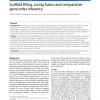Free Online Productivity Tools
i2Speak
i2Symbol
i2OCR
iTex2Img
iWeb2Print
iWeb2Shot
i2Type
iPdf2Split
iPdf2Merge
i2Bopomofo
i2Arabic
i2Style
i2Image
i2PDF
iLatex2Rtf
Sci2ools
BMCBI
2010
2010
Scaffold filling, contig fusion and comparative gene order inference
Background: There has been a trend in increasing the phylogenetic scope of genome sequencing without finishing the sequence of the genome. Increasing numbers of genomes are being published in scaffold or contig form. Rearrangement algorithms, however, including gene order-based phylogenetic tools, require whole genome data on gene order or syntenic block order. How then can we use rearrangement algorithms to compare genomes available in scaffold form only? Can the comparative evidence predict the location of unsequenced genes? Results: Our method involves optimally filling in genes missing from the scaffolds, while incorporating the augmented scaffolds directly into the rearrangement algorithms as if they were chromosomes. This is accomplished by an exact, polynomial-time algorithm. We then correct for the number of extra fusion/fission operations required to make scaffolds comparable to full assemblies. We model the relationship between the ratio of missing genes actually absent from...
Algorithm | BMCBI 2010 | Genomes | Scaffold |
| Added | 08 Dec 2010 |
| Updated | 08 Dec 2010 |
| Type | Journal |
| Year | 2010 |
| Where | BMCBI |
| Authors | Adriana Muñoz, Chunfang Zheng, Qian Zhu, Victor A. Albert, Steve Rounsley, David Sankoff |
Comments (0)

